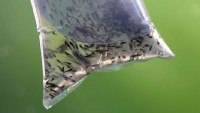WHO: Lindane Insecticides And DDT Can Lead To Cancer
| Marie de Vera | | Jun 26, 2015 05:52 AM EDT |
(Photo : Getty Images) Flag and logo of the World Health Organization WHO.
On Tuesday, the World Health Organization cancer agency says that a non-hodgkin lymphoma type of disease that can cause cancer to a human body was linked to the insecticide Lindane.
Based on reviews made by agriculture and chemical experts, lindane is classified as "carcinogenic to humans." The pesticide DDT or dichlorodiphenyltrichloroethane was labeled as "probably carcinogenic to humans" while the herbicide 2-4-D was rated as "possibly carcinogenic to humans." The review was headed by the International Agency for Research on Cancer.
Like Us on Facebook
The agency released a statement saying, "Epidemiological studies found positive associations between exposure to DDT and non-Hodgkin lymphoma, testicular cancer, and liver cancer."
This insecticide lindane was once widely used in agricultural fields and used to treat human lice and scabies. It was banned since 2009 and was restricted in most countries under the Stockholm Convention on Persistent Organic Pollutants, according to The Guardian.
While not totally banned, lindane is still used today to treat scabies and human lice albeit under close medical supervision.
Lindane-based shampoo is used to kill lice, while lotions from lindane are used to treat scabies when directly applied to skin. These products have been available since the early '50s and still approved by the FDA, according to Channel News Asia.
IARC head Dr. Kurt Straif told the BBC that no study was made in order to reassess the risks involved in these types of exposure.
On the other hand, Epidemiological studies did not find strong or increasingly consistent risk of NHL or other cancer related diseases from the 2, 4-D exposures. However, evidences somehow made it strong that it induces oxidative stress, a certain process in which it damages the cells in the human body and can suppress the human immune system based on moderate evidences.
Cases have been previously reported that there are already high exposures to lindane among agricultural workers and pesticide applicators.
"Large epidemiological studies of agricultural exposures in the United States and Canada showed a 60 percent increased risk of non-Hodgkin lymphoma in those exposed to lindane," it declared.
During World War Two, DDT was first introduced for controlling insect-borne diseases and was later used for eradicating malaria outbreak and for agricultural purposes, according to Reuters.
Occupational exposure to 2, 4-D can happen during manufacturing and application and usually people in general populated areas through food, water, dust or residential application and during spraying.
TagsDDT, insecticides, WHO, lindane, Cancer
©2015 Chinatopix All rights reserved. Do not reproduce without permission
EDITOR'S PICKS
-

Did the Trump administration just announce plans for a trade war with ‘hostile’ China and Russia?
-

US Senate passes Taiwan travel bill slammed by China
-

As Yan Sihong’s family grieves, here are other Chinese students who went missing abroad. Some have never been found
-

Beijing blasts Western critics who ‘smear China’ with the term sharp power
-

China Envoy Seeks to Defuse Tensions With U.S. as a Trade War Brews
-

Singapore's Deputy PM Provides Bitcoin Vote of Confidence Amid China's Blanket Bans
-

China warns investors over risks in overseas virtual currency trading
-

Chinese government most trustworthy: survey
-

Kashima Antlers On Course For Back-To-Back Titles
MOST POPULAR
LATEST NEWS
Zhou Yongkang: China's Former Security Chief Sentenced to Life in Prison

China's former Chief of the Ministry of Public Security, Zhou Yongkang, has been given a life sentence after he was found guilty of abusing his office, bribery and deliberately ... Full Article
TRENDING STORY

China Pork Prices Expected to Stabilize As The Supplies Recover

Elephone P9000 Smartphone is now on Sale on Amazon India

There's a Big Chance Cliffhangers Won't Still Be Resolved When Grey's Anatomy Season 13 Returns

Supreme Court Ruled on Samsung vs Apple Dispute for Patent Infringement

Microsoft Surface Pro 5 Rumors and Release Date: What is the Latest?













